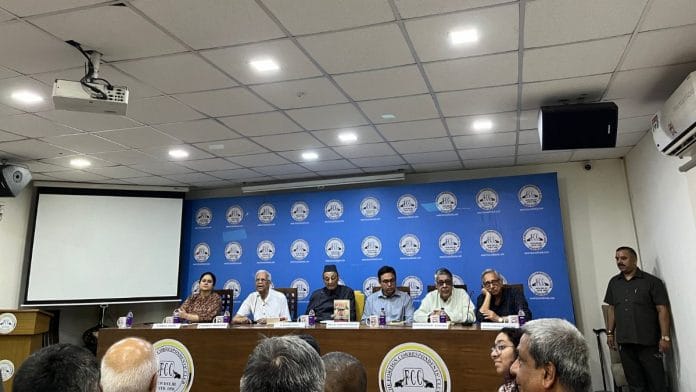New Delhi: Senior Congress leader Mani Shankar Aiyar’s controversial remark about the 1962 China-India war — which provided great fodder for Indian TV channels amid the Lok Sabha elections — seemed to have eclipsed news of an important book on former Prime Minister Jawaharlal Nehru released that day, on 28 May.
Aiyar was one of three panelists invited to launch senior journalist Kallol Bhattacherjee’s latest release, Nehru’s First Recruits: The Diplomats Who Built Independent India’s Foreign Policy. Launched a day after Nehru’s death anniversary, the book traces the formation of the Indian Foreign Service (IFS) and how many of the first ambassadors of independent India, who came from different walks of life, were personally vetted by Nehru.
It was a stellar panel comprising 93-year-old Karan Singh, former Rajya Sabha member and a tall figure in J&K politics; writer, historian and Jawaharlal Nehru University legend Purushottam Agrawal and Aiyar.
They seamlessly riffed off one another while discussing the book, and at times, took jibes at the ruling dispensation. Aiyar questioned the “intelligence” of the current Intelligence Bureau (IB), arguing that it seemed to be “the one quality they lacked”. Meanwhile, Agrawal drew a conclusion from an anecdote in the book on how Nehru once lambasted Hindi poet Harivansh Rai Bachchan for his verbose translation of the Vice President’s speech. (It is custom in India that the President delivers the address in English and usually the Hindi translation is read by the Vice President).
“While Bachchan was arguing that [then Vice President] Zakir Husain should practice…this translation, Nehru lost patience. He told Bachchan that there’s enough trouble in the country already. Unfortunately, we have gone down a route where the leaders in the country are not bothered about solving the troubles, but adding to them,” Agrawal said.
Singh, meanwhile, lamented recent attempts to “denigrate” Nehru. He also fondly remembered his Doon School classmates who eventually became some of Nehru’s first “recruits” in the foreign services, such as former foreign secretary KPS Menon Jr. and Ashok B Gokhale who had served in Washington DC.
“Even our English teacher joined the foreign service,” recalled Singh.
This touched upon one of the major takeaways from the book: that many of those invited to join India’s foreign service didn’t come from a diplomatic background. They were journalists, revolutionaries, radio jockeys, academics and so on. Bachchan is also a good example — he was a poet inducted into the Ministry of External Affairs (MEA).
Also read: Nehru had a diplomatic brigade. It had many soldiers from Bose’s Indian National Army
Fascinating period of Indian diplomatic service
Bhattacherjee’s research for the book began with mining a dense document ‘Statement of Services of Officers of Branches A and B of the Indian Foreign Service’ published in 1958 under Nehru’s supervision. KPS Menon Jr., the editor of the book, was tasked with compiling the biodata of all the diplomats who joined the MEA in the 1940s and the 1950s.
“This entire historic sweep is a fascinating period of Indian diplomatic history,” explained the author.
Interviews with four of the first recruits—Natwar Singh, Eric Gonsalves, Maharaja Krishna Rasgotra and Chinmaya Gharekhan—also substantiated the book’s findings.
“I felt, when I looked at the directory, it was not just a directory full of names and career details but a directory full of life, interesting events, characters and developments that need to be chronicled,” Bhattacherjee added.
Looking at the foreign service today, all of the panellists were in agreement that it is far more diverse. Back then, women would have their service cut short if they married, but this is no longer the case.
The foreign service was once an “upper class, upper caste” but that has changed, Aiyar said.
The panellists were speaking to a packed room, attended by some high-level diplomats such as the deputy chief of mission at the Colombia Embassy in India, Juan Carlos Rojas Arango, as well as some officials from the Bangladesh High Commission.
“It was helpful to listen to different perspectives. I was recently transferred to India [two months ago], and this helped broaden my understanding of Indian history and foreign policy,” Arango told ThePrint.
The book was launched at the Foreign Correspondents’ Club of South Asia in New Delhi.
(Edited by Ratan Priya)






